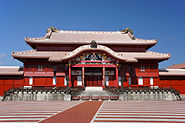
| History of Ryukyu |
|---|
  |
The Kaizuka Period[1] (Japanese: 貝塚時代, Kaizuka jidai); literally the "Shellmound Period" is one of the periods of the prehistory of the Okinawa and Amami Islands.[2] It is defined as the period of the prehistory in the Amami and Okinawa Islands with pottery. It lasts from 8000 BCE to the 11th or 12th centuries CE.[3] The culture that develops during this period is called the Kaizuka Culture (Japanese: 貝塚文化, Kaizuka bunka). It is divided into Early and Late Kaizuka Period, the difference residing in a shift in the settlement location and the development of trade with the neighbouring cultures, first Japan, and then China and Korea.
Economy is mainly based on gathering, fishing and hunting, the principal resources exploited being acorns, fishes and shellfishes. Settlements are limited in size, with the apparition of perennial villages by the end of the Early Kaizuka Period. The material culture is dominated by an important pottery production and very characteristic bone and shell artefacts.
From the 12th century, the Kaizuka Culture is followed by the Gusuku Culture, the first agricultural culture of the Okinawa Islands.[4]
In the Sakishima Islands, the southernmost part of the Ryūkyū Archipelago, the period parallel to the Okinawan Kaizuka Period is called the Sakishima Prehistoric Period. The Amami Islands, the northernmost part of the Ryūkyū Archipelago, first showed strong cultural relation with the Kaizuka Culture, before they shifted and got closer to the Japanese cultural sphere.[5]
- ^ Cite error: The named reference
:15was invoked but never defined (see the help page). - ^ 安里, 進 (1996). "考古学からみた現代琉球人の形成". 地学雑誌 (in Japanese). 105 (3).
- ^ 安里, 進; 土肥, 直美 (2011). 沖縄人はどこから来たか〈改訂版〉 琉球・沖縄人の起源と成立 [Where did Okinawans came from? Origin and evolution of Ryukyu and Okinawa Peoples] (in Japanese). ボーダーインク社.
- ^ Cite error: The named reference
:16was invoked but never defined (see the help page). - ^ 木下, 尚子 (2019). "縄文文化と沖縄の貝塚文化" [The Jomon Culture and the Okinawan Kaizuka Culture]. 荻堂貝塚発掘調査100年貝塚研究の新視点 (in Japanese). 沖縄考古学会: 13–24.